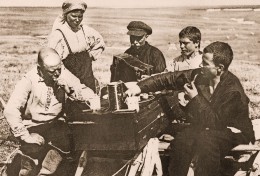Issue 2 (87)
| DECENTRALIZED FORMS OF LABOR ORGANIZATION IN THE INDUSTRY OF THE MIDDLE VOLGA REGION IN THE EARLY 20TH CENTURY | |||
|---|---|---|---|
| Year | 2025 | Number | 2 (87) |
| Pages | 158-167 | Type | scientific article |
| UDC | 94(470.40)“19” | BBK | 63.3(235.54)+65.9(235.54) |
| Authors | Arsentyev Viktor M. Makushev Andrey E. |
Topic | HISTORICAL AND ECONOMIC MOSAIC |
| Summary | The article considers the forms of industrial labor organization in the Middle Volga provinces in the early 20th century, which were not directly related to work in factory enterprises. Although the trend of growing concentration of labor force in the Russian industry was determinant on a macroeconomic scale, the picture was somewhat different at the micro level. In particular, in the industrial provinces of the Middle Volga region in the early 20th century, decentralized forms of labor organization typical for the proto-industrial stage of economic modernization were preserved. First of all, they mani- fested themselves in the work of distribution offices, which acted as customers for the production of industrial items as well as in the activities of factories and plants, outside of which some production processes and even entire stages of manufacturing of the finished product were taken out. The study revealed that the use of decentralized forms of labor organization in the Russian industry of the early 20th century remained quite a widespread and sustainable practice. In the Middle Volga region it was localized within the framework of the manufacture of felted shoes, tailoring of uniforms for the army (Kazan province), as well as flax spinning (Samara province), cotton (Saratov province), matchmaking (Penza province) and some other industries. The main reasons for the persistence of this phenomenon are the following: the slow pace of depeasantization and the underdevelopment of hired labor market; the possibility of additional profit for entrepreneurs due to cost reduction and minimization of expenditures on fixed capital; a smaller share of responsibility of employers to home-based workers compared to factory workers in accordance with the existing norms of labor legislation, etc. | ||
| Keywords | industry, entrepreneurship, Middle Volga region, workers, peasantry, industrial modernization, factory, scattered manufactory, distribution office | ||
| References |
Kruglikov A. L. Rabochiy klass tekstil’noy promyshlennosti Povolzh’ya v period imperializma (90-ye gg. XIX v. — 1917 g.): kand. dis. [The Working Class of the Textile Industry of the Volga Region during the Period of Imperialism (90s of the 19th Century — 1917): Diss. Cand.]. Kuibyshev, 1982. (in Russ.). Markushina S. V. Promyshlennost’ Saratovskoy gubernii v usloviyakh kapitalisticheskoy modernizatsii serediny XIX — nachala XX vv.: kand. dis. [Industry of the Saratov Province in the Conditions of Capitalist Modernization of the Mid-19th — Early 20th Centuries: Diss. Cand.]. Saratov, 2005. (in Russ.). Naumova G. R. Russkaya fabrika na etape kapitalisticheskoy industrializatsii (istochniki i metody issledovaniya): aftoref. doc. dis. [Russian Factory at the Stage of Capitalist Industrialization (Sources and Research Methods): Abstr. Diss. Doc.]. Moscow, 1998. (in Russ.). Nemtsy Rossii = Die Deutschen Russlands: Entsiklopediya. T. 3 [The Germans of Russia = Die Deutschen Russlands: Encyclopedia. Vol. 3]. Moscow: ERN Publ., 2006. (in Russ.). Solovieva A. M. Promyshlennaya revolyutsiya v Rossii v XIX v. [Industrial Revolution in 19th Century Russia]. Moscow: Nauka Publ., 1990. (in Russ.). |
||
| Download in PDF | |||
















